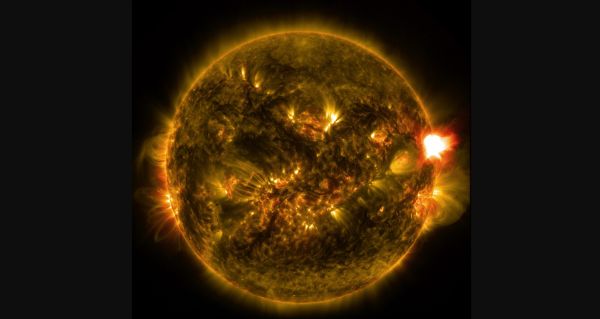
Scientists warn of powerful and potentially disruptive solar flare activity beginning today
Powerful solar flare activity capable of causing radio blackouts and interfering with short-wave communications has been forecast for today, Monday, July 17. Those solar flares are predicted to possibly be the class X-flares’ variety, and could include “proton flares, and short-wave radio conditions were expected to deteriorate,” according to The Tribune. The warning comes from the Russian Fedorov Institute of Applied Geophysics in Moscow after scientists there observed multiple solar flares yesterday.
X-class flares are the largest explosions in the solar systems and can create long-lasting radiation storms. Proton flares are a storm of solar energetic particles, composed chiefly of proton.
Solar flares happen when the powerful magnetic fields in and around the sun reconnect. They can affect Earth’s magnetic field with the potential to damage satellites and communications equipment, according to NASA. ~ Reuters
One of Sunday’s solar flares lasted 14 minutes in duration and disrupted radio communications.
CBS News shared a warning from the National Oceanographic and Atmospheric Administration (NOAA) that if we get hit with the strongest category of X-class solar flare, that they could be combined with smaller storms during the upcoming week and, “potentially cause worldwide transmission problems and blackouts, could be emitted this week, scientists say. On Sunday, radio blackouts were already detected, though scientists did not say where.”
X-class flares are the biggest category of solar flare activity and are essentially “explosions on the surface of the sun ranging from minutes to hours in length,” according to NASA, which calls X-class flares “the real juggernauts.” ~ CBS News
“Large flares can release enough energy to power the entire United States for a million years,” NASA says, adding that the most powerful X-class flare ever recorded was in 2003. That event “was so powerful that it overloaded the sensors measuring it,” NASA says.
Fear not though because NASA also tells us that, “most solar flares aren’t dangerous to humans on Earth.”
For more on the increased activity on the sun over the last few days which could start giving us communications problems beginning today and during the coming week, see the video accompanying this article.
Cover photo: The sun emitted a mid-level solar flare, peaking at 11:24 p.m. January 12, 2015. NASA’s Solar Dynamics Observatory, which watches the sun constantly, captured an image of the event. Solar flares are powerful bursts of radiation. Harmful radiation from a flare cannot pass through Earth’s atmosphere to physically affect humans on the ground, however — when intense enough — they can disturb the atmosphere in the layer where GPS and communications signals travel. Image credits, Image Credit: NASA/SDO
Posted by Richard Webster, Ace News Today / Follow Richard on Facebook, Twitter & Instagram






